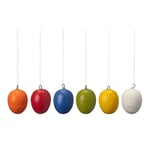Easter eggs absorbent cotton small

Easter eggs absorbent cotton small
- Environmentally friendly made of absorbent cotton (cellulose)
- According to a process handed down for 100 years
- Staining by a dip in gelatin
General Information
Upcycling. The egg from pulp
What stands the test of time (and more than meets the nerve of its respective time), that outlasts many a time and is perhaps someday called tradition. So it happened to the Easter bunny, so it happened to the Easter egg - and similarly it behaves with the procedure developed about a hundred years ago, according to which these Easter eggs are turned by hand in Thuringia.
Who should now come to think, because yet Thuringia is rather known for artistic handicrafts made of glass and porcelain or also for the processing of wood: Yes, these eggs are produced environmentally friendly from absorbent cotton (cellulose). Thus, Thuringia as a place of manufacture is again closer than the first impression suggests: Cellulose is obtained from wood, mostly from sawmill residues - and we are back to the traditional material and an optimal upcycling. A dip in colored gelatin hardens the Easter eggs from absorbent cotton finally and gives them their appealing decorative Easter shine.
The Egg and the Easter Celebrations.
Which came first: the rabbit or the egg? At Easter, we can make an unqualified case for the egg: Since the earliest beginnings of Christianity, the egg has been a symbol of fertility; it stands for new life and the resurrection of Christ. The Easter bunny, by contrast, had to prevail against illustrious competitors before it could establish itself as the exclusive egg supplier, depending on the region: the fox, the cuckoo and the stork – or even against the church bells flying home from Rome. Of course, not only the egg itself but also its colouring has a special significance. In the sphere of influence of the Orthodox Church, you found traditionally eggs dyed exclusively in red – in Christian symbolism, red stands for the blood of Christ. Over time and regionally differentiated, especially the Roman Catholic Church added other colours and significant meanings, for example, white symbolizing purity, yellow representing wisdom, and orange signifying endurance and strength.
Besides the festive-decorative purpose, there once was a thoroughly functional purpose that led to the dyeing of eggs (and, at the same time, to the tradition of hard-boiled Easter eggs): The peasants of the Middle Ages dyed their own eggs red to distinguish them from those they had to hand over to their landlord. What’s more, farmers preserved eggs by boiling them during the forty-day fasting period, when it was not allowed to eat eggs. Dyeing the different batches of eggs in one colour each helped colour-coding them before storing. The coding gave the farmers an overview of the growing supply of eggs and was an early form of best-before date. One could easily tell which batch of eggs comprised the oldest and was first in line for consumption.
Hint:
This product is an example of genuine handicraft; therefore, minor deviations in size and colour may occur.
Product Information
Article Number 205125
- Environmentally friendly made of absorbent cotton (cellulose)
- According to a process handed down for 100 years
- Staining by a dip in gelatin
Set of 6 Easter eggs (egg 3 × 2.5 cm) made of cotton wool (cellulose), coloured with gelatine. Tinplate holding loop. Total weight 20 g. Made in Germany.
Have a question?
If you have a question concerning this product you are welcome to contact us. For this your E-Mail program will open.
Contact Us
For advice, spare parts or special requests - our customer service will take care of your questions and concerns, personally and competently.
You can reach us from Monday to Friday at +49 2309 939095 or anytime at info@manufactum.com
Gift Certificates
It is good for everything: With our PDF gift certificates you can choose from the entire Manufactum selection. Pick a motif which you can send by email or print out and present personally, immediately after submitting your order.
Order now


